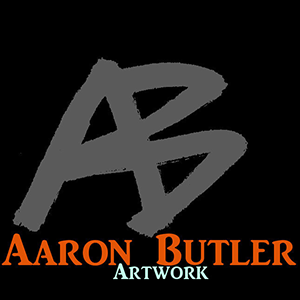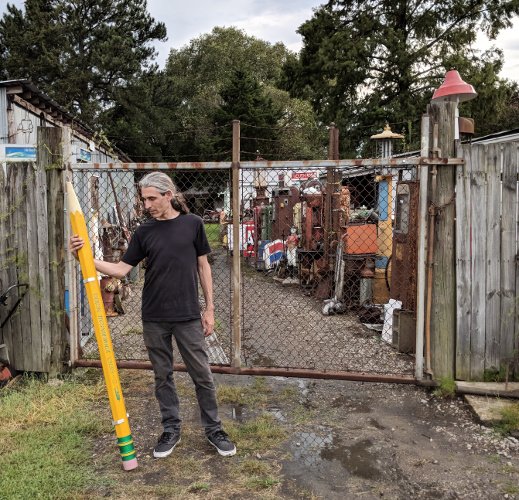”…The ability to make you perfectly aware of the current moment while at the same time traveling into your childhood is a difficult task; a task accomplished over and over in Aaron's work. The chipping feel of the metal, the splintery wood, all transport the mind into an era that we are currently not in, but must be aware of, in order to travel away from. An era of our grandparents' youth. Perhaps our own. An environment that allows the mind to take in what's real and travel into the beauty of imagination.”
-Alena LaBella, 2016
A Short Bio
Aaron’s days are generally spent making art, running his antique business, and renovating an 1850s stone farmhouse in York County, Pennsylvania. Originally from Columbus, Ohio, he studied illustration at the Columbus Colleges of Art & Design, before relocating to attend the former Art Academy of Cincinnati Museum School, where he received a BFA in Fine Arts in 1995. Aaron hosted several FM radio programs and played percussion in a grunge band, jam bands, jazz-rock fusion, and experimental ensembles in the 1990s and 2000s, including his own group Dark Audio Project. Since 2010 he has been collaborating with virtuoso guitarist Ric DelNero as Explorophonic, and they have released several albums with a revolving collective of musicians including author Scott Elliot Hicks, whose books also feature Aaron's artwork.
After working in art education, web design, graphic design, advertising, and as a handyman, in 2002 Aaron started buying and selling antiques full-time. He then became co-owner of a small gallery and shop in Jim Thorpe, PA for several years. Ever since, he has traveled the countryside looking for interesting antique finds and images to draw or photograph. In the past, he has exhibited paintings in numerous gallery and museum shows, but currently is focused on his sketchbook drawings and book projects.
_____
What is a Hole?
by Scott Elliot Hicks
When I encounter Aaron Butler's artwork, I am immediately drawn to the following questions: What is contained in a surface? What creates the feeling of the age of objects? Why is he attracted to old decaying junk? What work are the giant impossible machines trying to accomplish? What makes an object seem small or seem large? What is a hole?
Aaron finds inspiration in the bygone craftsman of advertising art, painting and modern design, incorporating elements of everyday objects into landscapes, interiors and space. He loves the practical art of the trade. Butler is gritty. He wants us to crawl behind the walls with him, to the place where only the mice or the imagination can penetrate. He brings pale color to the black and white. Human life, nostalgically and fluidly interweaving with stripped and peeling paint, torn, yellowed paper, and melting close-ups. But there is humor lying at the bottom of his art - in the fun that kids have in old buildings, in his child-size perspective and playful creation of new machines built on a single wire.
And peanuts.
For the most part it is a positive, energetic world that Butler's art portrays. It is rarely gruesome or insane: the folk art inspired junkyards are more Robert Crumb than Francis Bacon. It is a little trippy but not freaked out. There is a concentration on detail and replication of what is only remembered. But all painters want to stop time. The minute precision of graphite and ink want to show us the remarkable and unique beauty in old knots, wood grain and random objects. We can never quite grasp what is shown, so we must study his works repeatedly.
Does he wish to show the human within the impossible landscapes and run-down motels? If he shows what the human being is, one finds it in the architectural corner and the heightened focus of organized chaos. Butler controls our gaze like any good artist, but where do we melt together with the color of the wall? Yes, one could say that he takes inspirations from photos of old stuff that he sees along the road, but it would be superficial to say that his work is interpretational or representational - there is a cosmic riddle in there. Maybe the time machine is the painting itself, and perhaps some of the eternal shines through.
_____

